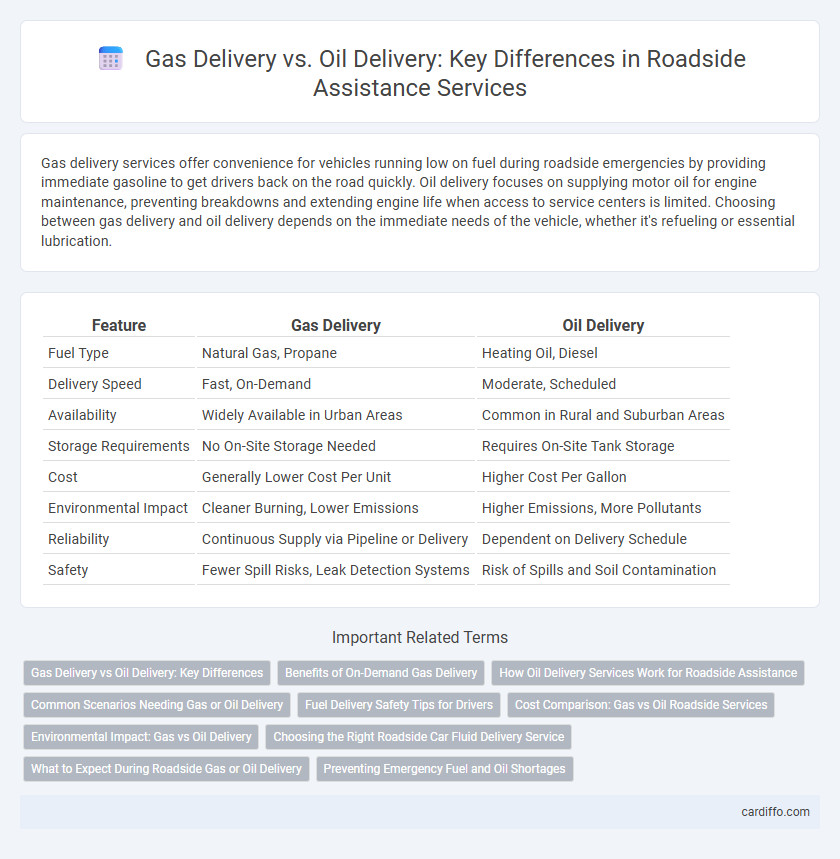Gas delivery services offer convenience for vehicles running low on fuel during roadside emergencies by providing immediate gasoline to get drivers back on the road quickly. Oil delivery focuses on supplying motor oil for engine maintenance, preventing breakdowns and extending engine life when access to service centers is limited. Choosing between gas delivery and oil delivery depends on the immediate needs of the vehicle, whether it's refueling or essential lubrication.
Table of Comparison
| Feature | Gas Delivery | Oil Delivery |
|---|---|---|
| Fuel Type | Natural Gas, Propane | Heating Oil, Diesel |
| Delivery Speed | Fast, On-Demand | Moderate, Scheduled |
| Availability | Widely Available in Urban Areas | Common in Rural and Suburban Areas |
| Storage Requirements | No On-Site Storage Needed | Requires On-Site Tank Storage |
| Cost | Generally Lower Cost Per Unit | Higher Cost Per Gallon |
| Environmental Impact | Cleaner Burning, Lower Emissions | Higher Emissions, More Pollutants |
| Reliability | Continuous Supply via Pipeline or Delivery | Dependent on Delivery Schedule |
| Safety | Fewer Spill Risks, Leak Detection Systems | Risk of Spills and Soil Contamination |
Gas Delivery vs Oil Delivery: Key Differences
Gas delivery provides immediate fueling services using compressed natural gas (CNG) or liquid petroleum gas (LPG) for vehicles, whereas oil delivery involves transporting lubricants and motor oils essential for engine maintenance. Gas delivery systems require specialized infrastructure like pressurized tanks and safety protocols for flammable gases, while oil delivery emphasizes leak-proof containers and temperature-controlled storage to preserve oil quality. Understanding these key differences ensures efficient roadside support tailored to specific vehicle energy and maintenance needs.
Benefits of On-Demand Gas Delivery
On-demand gas delivery provides a faster and more convenient solution for motorists stranded without fuel, eliminating the need to search for a nearby gas station. This service enhances safety by reducing the risk of running out of gas in dangerous or isolated locations. Gas delivery trucks are equipped with proper safety measures and operate 24/7, ensuring reliable assistance anytime and anywhere on the roadside.
How Oil Delivery Services Work for Roadside Assistance
Oil delivery services for roadside assistance involve transporting and supplying engine oil directly to stranded vehicles, ensuring swift maintenance without needing a tow. Trained technicians assess oil levels and refill or replace oil on-site, preventing potential engine damage and minimizing downtime. This service integrates with roadside assistance platforms, providing timely, convenient solutions for motorists in need of emergency oil maintenance.
Common Scenarios Needing Gas or Oil Delivery
Common scenarios needing gas delivery include vehicle breakdowns due to empty fuel tanks, emergency refills during long-distance travel, and remote locations lacking nearby gas stations. Oil delivery is often required for engine lubrication top-ups in older vehicles experiencing leaks, during routine maintenance to prevent breakdowns, and in heavy machinery operating in harsh environments where oil levels deplete rapidly. Both services ensure vehicle operability by addressing critical fluid shortages promptly and efficiently.
Fuel Delivery Safety Tips for Drivers
Fuel delivery safety tips for drivers emphasize proper handling and storage to prevent spills and fire hazards during both gas delivery and oil delivery. Drivers should ensure that all fuel containers are securely fastened, use appropriate personal protective equipment, and avoid smoking or open flames near the delivery area. Following industry regulations and maintaining clear communication with dispatchers can minimize risks and enhance roadside safety.
Cost Comparison: Gas vs Oil Roadside Services
Gas delivery roadside services generally cost less than oil delivery due to lower product prices and simpler handling requirements. Oil delivery often involves specialized equipment and higher transportation fees, increasing overall service expenses. Pricing for gas roadside assistance typically ranges from $50 to $100, while oil delivery services can exceed $150 depending on location and service complexity.
Environmental Impact: Gas vs Oil Delivery
Gas delivery typically results in lower carbon emissions compared to oil delivery, as natural gas burns cleaner with fewer pollutants. Oil delivery often involves higher environmental risks due to potential leaks and spills, which can contaminate soil and water. Vehicles designed for gas delivery also tend to have improved fuel efficiency, reducing their overall ecological footprint.
Choosing the Right Roadside Car Fluid Delivery Service
Choosing the right roadside car fluid delivery service depends on whether you need gas delivery or oil delivery, as each addresses different vehicle needs. Gas delivery is essential for refueling stranded vehicles quickly to prevent engine shutdown, while oil delivery provides crucial engine lubrication to avoid long-term mechanical damage. Evaluating factors such as response time, fluid type availability, and service reliability ensures optimal roadside assistance tailored to immediate vehicle requirements.
What to Expect During Roadside Gas or Oil Delivery
During roadside gas delivery, expect prompt fuel refilling directly at your vehicle's location, enabling you to continue your journey without the need to visit a gas station. Oil delivery services typically involve transporting essential engine oil to your roadside location, ensuring quick maintenance such as topping off or oil changes to prevent engine damage. Both services prioritize fast response times, professional handling, and use of proper safety measures to protect your vehicle and surroundings during the delivery process.
Preventing Emergency Fuel and Oil Shortages
Gas delivery services provide immediate replenishment of fuel to vehicles stranded on the roadside, preventing emergency fuel shortages and ensuring timely continuation of travel. Oil delivery, on the other hand, addresses critical lubrication needs, safeguarding engine performance and preventing breakdowns caused by oil depletion. Both services play a vital role in comprehensive roadside assistance by actively mitigating risks related to fuel and oil emergencies.
Gas Delivery vs Oil Delivery Infographic

 cardiffo.com
cardiffo.com